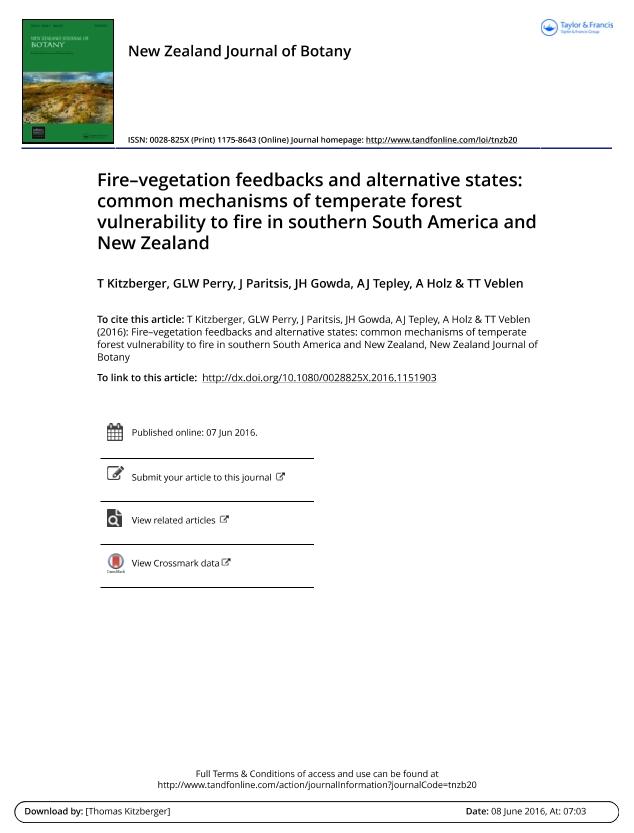Mostrar el registro sencillo del ítem
dc.contributor.author
Kitzberger, Thomas

dc.contributor.author
Perry, G.L.W.
dc.contributor.author
Paritsis, Juan

dc.contributor.author
Gowda, Juan Janakiram Haridas

dc.contributor.author
Tepley, A. J.
dc.contributor.author
Holz, Andrés

dc.contributor.author
Veblen, Thomas

dc.date.available
2019-03-11T19:37:38Z
dc.date.issued
2016-04-07
dc.identifier.citation
Kitzberger, Thomas; Perry, G.L.W.; Paritsis, Juan; Gowda, Juan Janakiram Haridas; Tepley, A. J.; et al.; Fire–vegetation feedbacks and alternative states: common mechanisms of temperate forest vulnerability to fire in southern South America and New Zealand; Royal Society of New Zealand; New Zealand Journal of Botany; 54; 2; 7-4-2016; 247-272
dc.identifier.issn
0028-825X
dc.identifier.uri
http://hdl.handle.net/11336/71378
dc.description.abstract
In the context of global warming and increasing impacts of invasive plants and animals, we examine how positive fire–vegetation feedbacks are increasing the vulnerability of pyrophobic temperate forests to conversion to pyrophytic non-forest vegetation in southern South America and New Zealand. We extensively review the relevant literature to reveal how these temperate southern hemisphere floras have generated similar positive fire–vegetation feedback mechanisms resulting in increased vulnerability to anthropogenically altered fire regimens. For the two regions, we address the following questions. 1. What are the major plant species, physiognomic types and functional types characteristic of pyrophytic versus pyrophobic vegetation types and how do their traits affect flammability, resistance to fire and recovery after fire? 2. What are the roles of herbivory and microclimate in enhancing fire–vegetation feedbacks? 3. Are there similarities in trends of cover type transitions in relation to altered fire regimens? 4. How are climate change, land-use trends and the effects of introduced plants and animals affecting the vulnerability of these ecosystems to fire-induced transitions to alternative stable states? Most temperate forests of New Zealand and southern South America evolved under conditions of low fire frequencies so few taxa became adapted to recurrent fire. Current dichotomous landscapes consisting of juxtaposed pyrophobic and pyrophytic vegetation types are the outcome of the expansion of fire-resilient and fire-promoting species associated with the arrival of humans. Despite considerable differences in human history and biogeographic history, the case studies presented here show remarkable parallels in life-history traits of the key pyrophobic taxa, fire–vegetation feedback mechanisms, overall ecosystem responses to anthropogenic alteration of fire regimens, and likely vulnerability to expected global change influences on future fire regimens.
dc.format
application/pdf
dc.language.iso
eng
dc.publisher
Royal Society of New Zealand

dc.rights
info:eu-repo/semantics/openAccess
dc.rights.uri
https://creativecommons.org/licenses/by-nc-sa/2.5/ar/
dc.subject
Alternative Stable States
dc.subject
Argentina
dc.subject
Bamboo
dc.subject
Chile
dc.subject
Flammability
dc.subject
Kunzea
dc.subject
Leptospermum
dc.subject
New Zealand
dc.subject
Nothofagus
dc.subject
Rainforest
dc.subject
Shrubland
dc.subject.classification
Otras Ciencias Biológicas

dc.subject.classification
Ciencias Biológicas

dc.subject.classification
CIENCIAS NATURALES Y EXACTAS

dc.title
Fire–vegetation feedbacks and alternative states: common mechanisms of temperate forest vulnerability to fire in southern South America and New Zealand
dc.type
info:eu-repo/semantics/article
dc.type
info:ar-repo/semantics/artículo
dc.type
info:eu-repo/semantics/publishedVersion
dc.date.updated
2019-02-12T16:57:14Z
dc.identifier.eissn
1175-8643
dc.journal.volume
54
dc.journal.number
2
dc.journal.pagination
247-272
dc.journal.pais
Nueva Zelanda

dc.journal.ciudad
Auckland
dc.description.fil
Fil: Kitzberger, Thomas. Consejo Nacional de Investigaciones Científicas y Técnicas. Centro Científico Tecnológico Conicet - Patagonia Norte. Instituto de Investigaciones en Biodiversidad y Medioambiente. Universidad Nacional del Comahue. Centro Regional Universidad Bariloche. Instituto de Investigaciones en Biodiversidad y Medioambiente; Argentina. Universidad Nacional del Comahue. Centro Regional Universitario Bariloche. Laboratorio de Ecotono; Argentina
dc.description.fil
Fil: Perry, G.L.W.. University of Auckland; Nueva Zelanda
dc.description.fil
Fil: Paritsis, Juan. Consejo Nacional de Investigaciones Científicas y Técnicas. Centro Científico Tecnológico Conicet - Patagonia Norte. Instituto de Investigaciones en Biodiversidad y Medioambiente. Universidad Nacional del Comahue. Centro Regional Universidad Bariloche. Instituto de Investigaciones en Biodiversidad y Medioambiente; Argentina. Universidad Nacional del Comahue. Centro Regional Universitario Bariloche. Laboratorio de Ecotono; Argentina
dc.description.fil
Fil: Gowda, Juan Janakiram Haridas. Consejo Nacional de Investigaciones Científicas y Técnicas. Centro Científico Tecnológico Conicet - Patagonia Norte. Instituto de Investigaciones en Biodiversidad y Medioambiente. Universidad Nacional del Comahue. Centro Regional Universidad Bariloche. Instituto de Investigaciones en Biodiversidad y Medioambiente; Argentina. Universidad Nacional del Comahue. Centro Regional Universitario Bariloche. Laboratorio de Ecotono; Argentina
dc.description.fil
Fil: Tepley, A. J.. Smithsonian Conservation Biology Institute; Estados Unidos
dc.description.fil
Fil: Holz, Andrés. Portland State University; Estados Unidos
dc.description.fil
Fil: Veblen, Thomas. University of Colorado; Estados Unidos
dc.journal.title
New Zealand Journal of Botany

dc.relation.alternativeid
info:eu-repo/semantics/altIdentifier/url/https://www.tandfonline.com/doi/full/10.1080/0028825X.2016.1151903
dc.relation.alternativeid
info:eu-repo/semantics/altIdentifier/doi/http://dx.doi.org/10.1080/0028825X.2016.1151903
Archivos asociados
